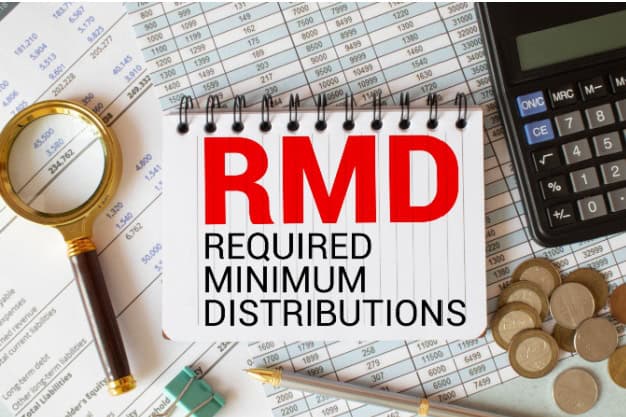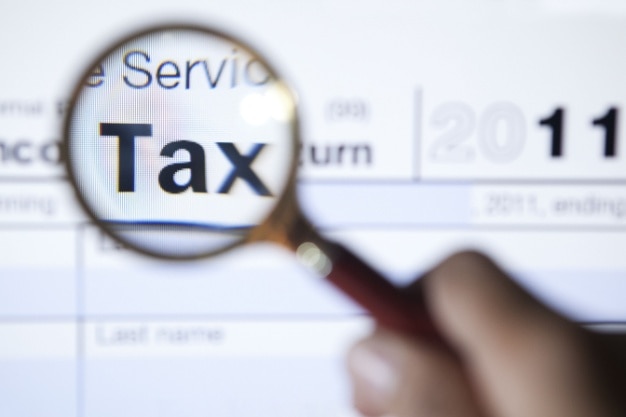Navigating RMDs: A Guide for the 55+ Conservative Crowd
March 21, 2024

Imagine stepping into the world of retirement planning, only to find a maze of rules that seem as complex as deciphering ancient hieroglyphs. At the heart of this labyrinth lies the concept of Required Minimum Distributions (RMDs). It’s not just another term to gloss over. No, it represents a pivotal moment in how you manage your golden years’ savings.
RMDs might sound dry and tedious. Yet, they hold power – power over your financial future and how comfortably you can sail through retirement. Many overlook them until it’s too late, facing hefty penalties that could have been easily avoided.
For years, you’ve diligently amassed a considerable sum for your golden years. Now comes the crucial part: understanding when Uncle Sam says it’s time to start withdrawing from your hard-earned savings. And yes, there are strict timelines and calculations involved.
The clock starts ticking louder once you hit 72 – a magic number where RMDs kick in like an uninvited but inevitable guest at your retirement party.
Table Of Contents:
- Understanding Required Minimum Distributions (RMDs)
- Calculating Your RMD
- Tax Implications of RMDs
- First-Year RMD Rules
- Roth IRAs and RMD Exemptions
- Inherited IRA RMD Considerations
- Withdrawal Options for Meeting Your RMD
- Special Exceptions and Considerations
- Conclusion
Understanding Required Minimum Distributions (RMDs)
Diving into the essentials of Required Minimum Distributions (RMDs), let’s explore their significance and the repercussions of overlooking them. Trust me; it’s something you want to get right.
What Are RMDs?
RMD stands for Required Minimum Distribution. Think of it as the minimum amount you must withdraw from your retirement accounts each year once you hit a certain age. Why? This rule is in place to prevent people from simply hoarding their money in accounts that offer tax benefits indefinitely. Uncle Sam wants his share, eventually.
The Importance of Timely Withdrawals
Falling behind on your RMDs can cost you big time—like 50% of what you were supposed to take out but didn’t. Ouch. That’s not a typo; failing to meet those withdrawals hits hard where it hurts: your wallet.
Age Requirements for RMDs
Gone are the days when 70½ was the magic number to start thinking about RMDs. Now, the starting line is at age 72. This gives your money more room to grow before dipping into that pot.
- If born before July 1st, 1949: Start at age 70½
- Born after June 30th, 1949: The countdown begins at age 72
Making sure we’ve got all our ducks in a row with our retirement plans isn’t just smart—it’s crucial. From understanding how much we need to pull out each year without getting dinged by penalties, to knowing when this financial dance starts depending on our birth date, it’s all about staying informed and ahead of the game.
Calculating Your RMD
Let’s get down to brass tacks on how Required Minimum Distributions (RMDs) are figured out. Figuring this out isn’t exactly a walk in the park, but understanding a few critical elements can really clear things up.
Factors Affecting RMD Calculation
Your retirement account doesn’t just sit there; it has a mission. Part of that mission involves figuring out your RMDs. Two big players in this game: your account balance and how long you’re expected to live – yeah, life expectancy plays a huge role here.
- Account Balance: The total amount you’ve got stashed in your retirement accounts as of December 31st the year before is what we’re talking about here. Bigger balance? Bigger RMD.
- Life Expectancy Factor: There’s this thing called the Uniform Lifetime Table, courtesy of our friends at the IRS. It estimates how long folks like us are going to live, statistically speaking, and helps calculate our annual withdrawals based on that number.
If math wasn’t your favorite subject, no worries – most plan administrators will do these calculations for you. But if you’re curious or want to double-check their work because who trusts anyone these days right?, grab that end-of-year account statement and check out the Uniform Lifetime Table linked above. Then it’s just some simple division – but remember, with great power comes great responsibility…to make sure those numbers add up correctly.
The idea behind all this? To spread out your retirement savings so they last throughout your lifetime while also satisfying Uncle Sam’s thirst for tax revenue on previously untaxed dollars. You’ve been socking away money into these accounts for years; now let’s make sure they serve their purpose without giving too much back in penalties or taxes.
Key Takeaway:
Understanding RMDs means knowing two main things: the total of your retirement funds as of December 31st last year and how long you’re expected to live, according to IRS tables. These figures help ensure your savings stretch over your lifetime while meeting tax obligations.
Tax Implications of RMDs
Let’s talk turkey—or in this case, taxes. Required Minimum Distributions (RMDs) aren’t just a part of your retirement plan; they’re also a piece of the tax puzzle you need to fit in every year.
Reporting RMDs on Your Tax Return
First things first: When it comes time to file your taxes, those RMDs you’ve been taking? They’ve got to be reported as taxable income. That’s right, Uncle Sam wants his share.
RMDs from traditional IRAs or employer-sponsored plans like 401(k)s are taxed as ordinary income at your current tax rate. This means that the amount you withdraw adds directly onto your total annual income—pushing up that number and potentially nudging you into a higher tax bracket.
- The kicker: Fail to report them? If you overlook reporting, brace yourself for fines in addition to the back taxes you owe. Not exactly ideal when you’re trying to enjoy retirement.
- The good news? Roth IRAs get off scot-free during the owner’s lifetime since those contributions were already taxed before they went in. But keep an eye out for inherited Roth accounts; different rules apply there.
To nail down what goes where on your tax return, look towards Form 1040 or 1040-SR—you’ll list these distributions along with any other sources of income. If keeping track feels like herding cats, consider consulting with a tax pro who can help make sure everything is squared away properly and punctually because let’s face it: Taxes are complicated enough without adding “missed RMD penalty” into the mix.
In essence, managing how these withdrawals affect your yearly taxes takes some doing but remember—it’s all about staying ahead so April doesn’t bring unwelcome surprises along with spring flowers.
First-Year RMD Rules
Navigating your first Required Minimum Distribution (RMD) can feel like trying to solve a puzzle with missing pieces. But don’t worry, we’ve got the roadmap right here.
Deadline for Your First RMD
Mark your calendar. If you turned 72 this year, you’re on the clock. The IRS gives you until April 1st of the next year to take your first dip into your retirement savings. Yes, that’s no April Fool’s joke.
This deadline is crucial because it marks the start of an annual tradition – taking money out of your retirement accounts, whether it’s a traditional IRA or 401(k). And while deciding what to do with that cash might be fun, missing this date is anything but.
- The scoop: You must take your first RMD by April 1 following the year you reach age 72.
- The catch: Wait until April and you’ll have two withdrawals in one tax year since all subsequent RMDs need to be taken by December 31 annually.
This timing trick can bump up your taxable income significantly for that year – not exactly ideal if keeping taxes low is part of your game plan. Imagine working hard all these years only to give Uncle Sam more than his fair share just because of timing.
Moral of the story? Getting ahead pays off—literally—in reduced stress and potentially lower taxes. So consider taking that initial withdrawal before the end-of-year festivities kick in. This way, when everyone else is stressing about their holiday shopping list, yours will already include “first RMD: done.”
If math isn’t quite your thing or deadlines sneak up on you like ninjas in the night, check out some tools to help calculate and manage those pesky distributions efficiently.
Key Takeaway:
Mark your calendar and beat the rush. Taking your first RMD before year-end can save you stress and lower taxes. Remember, waiting until April means double trouble with two withdrawals in one tax year.
Roth IRAs and RMD Exemptions
Let’s talk about a bright spot in the retirement planning world: Roth IRAs. Unlike their traditional counterparts, Roth IRAs come with a pretty sweet perk during the owner’s lifetime. Yep, you guessed it – they’re exempt from Required Minimum Distributions (RMDs). Exploring this, we uncover how it directly benefits your financial future.
What Makes Roth IRAs Special?
Roth IRAs stand out because they offer tax-free growth and withdrawals in retirement, provided certain conditions are met. But here’s the kicker: as long as you’re alive, the IRS doesn’t make you take money out of your Roth IRA every year after reaching age 72. That rule is strictly for other types of retirement accounts.
This privilege lets your funds mature undisturbed, free from the grasp of taxes or compulsory distributions. Imagine that—your money getting to chill out and potentially grow bigger without having to take any unscheduled breaks.
The Nitty-Gritty Details
- No RMDs During Your Lifetime: As long as the original account holder is breathing, there’s no need to worry about taking minimum distributions from a Roth IRA.
- Tax-Free Withdrawals: Since contributions are made with after-tax dollars, both your investment earnings and withdrawals are tax-free in retirement.
- A Sweet Deal for Heirs: Even though heirs must eventually take distributions from an inherited Roth IRA (thanks to recent legislation changes), these can be spread over their life expectancy under most circumstances—and remain tax-free.
If maximizing your legacy while enjoying flexibility sounds like music to your ears then diving deeper into how Roth IRAs work makes sense. Remember folks; when it comes down to making those golden years shine even brighter—a little knowledge goes a long way.
Inherited IRA RMD Considerations
When you inherit an IRA, the road ahead isn’t as straight as you might think. Especially when it comes to Required Minimum Distributions (RMDs), things can get a bit twisty.
What Are RMDs?
RMDs are those pesky withdrawals the IRS requires account holders to take out yearly from their retirement accounts once they hit a certain age. But here’s where it gets interesting for inherited IRAs: The rules shift based on your relationship with the original account owner.
The Importance of Timely Withdrawals
Miss an RMD and bam. You’re looking at a penalty. For inherited IRAs, this means keeping up with withdrawals could be even more critical because failing to do so slaps you with a 50% charge on what should have been distributed.
Age Requirements for RMDs
If you thought there was just one set age for everyone, guess again. When inheriting an IRA, your required start date for taking distributions can depend on several factors including whether the original owner had started their own distributions and your relation to them. Investopedia explains this well.
Cash vs In-Kind Distributions
Say what? Yes, besides how much and when, there’s also flexibility in ‘how’ these distributions come about – either as cash or perhaps shares if that suits better.
All said though, navigating through inherited IRA can be complex.
Withdrawal Options for Meeting Your RMD
The IRS doesn’t just throw a rule book at you and leave you to figure it out. They offer some flexibility when it comes to how you can meet your Required Minimum Distributions (RMDs). Let’s dive into the options available, focusing on cash versus in-kind distributions.
Cash vs. In-Kind Distributions
When it’s time to take your RMDs from your retirement accounts, most folks think about withdrawing cold hard cash. But there’s another way that might not have crossed your mind: in-kind distributions.
- Cash: The straightforward method. You withdraw funds from your account, which lands directly into your bank account or pocket – ready to spend or invest as you see fit.
- In-Kind: This is where things get interesting. Instead of converting everything into cash, you can transfer securities or other assets directly out of the retirement plan without selling them first. Think stocks, bonds, mutual fund shares – pretty neat if those investments are dear to your heart (or portfolio).
Opting for this route is not merely a matter of taste; it can also serve as a clever maneuver. Say the market’s down and selling would lock in losses; opting for an in-kind distribution lets those investments live another day – potentially recovering outside of the tax-deferred umbrella of a retirement account.
You needn’t fret over locking yourself into one option either; mix and match based on what suits each year’s circumstances best.
The bottom line? The IRS gives us more room than we might realize when taking our RMDs – offering both traditional withdrawals through cash-outs and less conventional routes like in-kind distributions. This flexibility means we’ve got options galore for managing our finances smartly during retirement years.
Special Exceptions and Considerations
Let’s face it, not all rules are set in stone. And when we’re talking about Required Minimum Distributions (RMDs), there are a few curveballs that life can throw at us. One of the most interesting exceptions? If you’re still clocking in past age 72.
Working Beyond Age 72
If you’ve hit the big seven-two but aren’t ready to hang up your work boots just yet, there’s good news for your retirement plans—literally. For those who continue working and have a 401(k) with their current employer, standard RMD rules take a backseat.
This special exception lets folks delay taking distributions from their current employer’s plan until they finally decide to retire, giving their savings more time to grow. But remember, this only applies if you don’t own more than 5% of the company.
- No RMDs required while still employed
- Applies only to current employer’s plan
- You must not be a 5% owner of the company
This break from regular RMD regulations means more flexibility for seniors choosing when they want to retire and start tapping into their retirement accounts without worrying about penalties or rushing into decisions due to tax implications on undistributed amounts.
Note though: This doesn’t apply across the board; IRAs and old employers’ plans still follow traditional RMD rules. So make sure you know which accounts fall under which guidelines.
In essence, being active in the workforce gives senior employees an edge by allowing them additional growth potential within certain retirement funds—an advantage worth considering as part of broader financial planning post-age-72 strategies.
Conclusion
Navigating the labyrinth of Required Minimum Distributions has been like piecing together a puzzle, slowly uncovering its secrets piece by piece. It’s not just another set of dry rules; it’s your ticket to a worry-free retirement, ensuring that hefty penalties don’t nibble away at your hard-earned savings.
RMDs might seem like an uninvited guest as you step into the age of 72, but they’re really more like that wise old friend who insists you start dipping into your treasure chest for golden years well spent. We uncovered how these distributions are calculated and the tax implications they carry—essentials for keeping Uncle Sam happy without giving up more than necessary.
The journey highlighted special scenarios too—from first-year deadlines to Roth IRAs’ exemptions—and even peered into the realm of inherited IRAs with their unique considerations. And let’s not forget those still working past 72; there’s some wiggle room for you as well.
Grasping the intricacies of Required Minimum Distributions means essentially commandeering your monetary destiny as you sail into retirement. They say knowledge is power, and armed with what we’ve explored today, consider yourself empowered. With the insights gained today, you’re ready to tackle this vital part of ensuring a smooth financial journey into retirement with both assurance and skill.
Remember, every detail matters when it comes to safeguarding those golden years against unnecessary taxes or penalties because yes—you’ve earned this respite. Let’s make sure it’s everything you envisioned and more by staying ahead with smart planning around RMDs.












